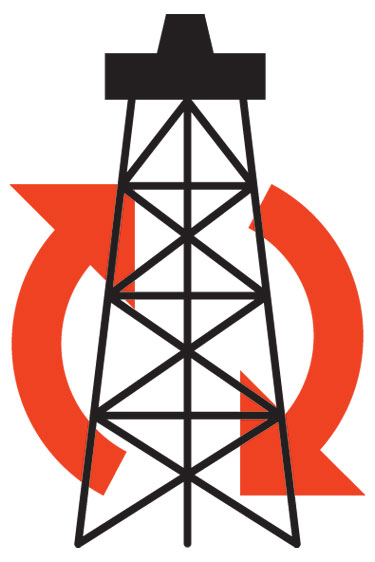It spawned a domestic energy revolution, minted a new set of billionaires, and cushioned the North Texas economy against the Great Recession.
That’s quite a list of achievements. But now, the Barnett Shale appears to have lost its mojo.
Drilling activity in the huge natural gas field that lies under Fort Worth and 24 area counties finished 2012 at its lowest point in years. In late December, there were only about 30 rigs operating in the Barnett, off from an average of 88 in 2010 and more than 160 in 2008.
There’s still plenty of gas to be recovered, but the tricks learned in the Barnett are now being used to open up other shale fields across the United States. And many of those oil and gas plays have gained the upper hand.
With natural gas prices sinking below $2 per 1,000 cubic feet last spring, producers shifted resources to focus on oil and other liquids, which command better prices. And so rigs have moved to places like the Eagle Ford in south Texas and the Bakken in North Dakota, taking workers and investment dollars with them.
Even other gas fields, like the huge Marcellus, centered in Pennsylvania, have stolen resources and attention from the Barnett, with lower operating costs and higher production volumes.
“The Barnett was the best play and then it wasn’t, almost overnight,” says Dave Pursell, managing director of Tudor Pickering Holt & Co., an energy-oriented investment banking firm in Houston.
Pursell doesn’t foresee an uptick in activity any time soon. Gas prices, which started the year around $3.25, need to reach at least $4.50 for producers to make money in the Barnett, he said, and that’s unlikely to happen for at least three years.
Despite the slowdown, it’s hard to overstate the financial impact of the Barnett Shale on North Texas. Waco economist Ray Perryman has pegged the juggernaut’s economic output at $65.4 billion between 2001 and 2011, including more than 100,000 jobs.
Cities, school districts, and other government bodies have reaped tens of millions of dollars from drilling on their lands. In Tarrant County alone, gas drilling provided more than $600 million in bonus and royalty money to a dozen public entities, including the cities of Fort Worth and Arlington and Dallas/Fort Worth International Airport, between 2008 and 2011, according to an analysis by the Fort Worth Star-Telegram.
But the drilling boom also created a glut of natural gas, pushing prices down just as the economy went south.
“We’ve been a victim of our own success,” said Julie Wilson, vice president of urban development at Chesapeake Energy in Fort Worth.
A number of factors combined to hurt the Barnett’s competitive position.
As the nation’s first big shale play, the Barnett saw a leasing frenzy that sent bonus offers as high as $30,000 an acre—clearly a bubble, in hindsight. After gas prices collapsed, it became difficult for producers to recover their “sunk costs” through production. Some sold out of the Barnett while others drilled just enough to keep control of their leases and wait for prices to recover.
The complications of drilling in an urban area became apparent as cities drafted ordinances, residents grew wary of trucks and pipelines, and environmentalists raised questions about the safety of hydraulic fracturing. Costs increased.
Meanwhile, competition quickly developed. When drilling first took off in the Barnett, it appeared to be unique. But before long, other fields such as the Haynesville in Louisiana and the Marcellus proved to be bigger and more profitable.
Last year, Standard & Poor’s estimated that the Marcellus could contain almost half of the nation’s proven natural gas reserves and has the lowest production cost of any gas field in the country.
“The Marcellus works at $3.50 (gas) and the Barnett doesn’t because there’s just more recovery,” Pursell says.
Boom and bust is a familiar cycle in the oil patch, but don’t mistake this slowdown as a bust. The Barnett remains a huge economic resource. Even with the pullback in drilling, production has continued to increase. And wells are expected to produce gas for two or three decades.
Bruce Bullock, director of the Maguire Energy Institute at SMU’s Cox School of Business, said the Barnett will always be known as the place where America’s shale revolution began, perhaps the launching pad to energy independence. As a proven field, he thinks it will emerge as a laboratory where production companies test new technologies, much as the North Sea is used in offshore drilling.
If there’s a move to develop export markets or convert long-haul truck fleets to natural gas, “you could see a significant pickup in activity,” he says.
Wilson says Chesapeake remains positive as well: “We have 2,700 wells, and we think there’s the opportunity to come back and more than double that.”
In the meantime, maybe it’s not all bad that attention has shifted to other places. In Hollywood’s take on gas drilling, Matt Damon plays a landman who becomes conflicted as a small town weighs the risks and benefits of fracking.
Promised Land is set in rural Pennsylvania, not Texas. I doubt anyone at the chamber of commerce is complaining about that.






